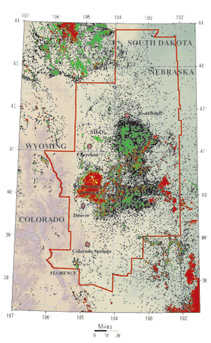| Using a geology-based assessment methodology, the U.S. Geological Survey estimated a mean of 183 trillion cubic feet of undiscovered natural gas, a mean of 2,350 million barrels of undiscovered oil, and a mean of 3,160 million barrels of undiscovered natural gas liquids in six provinces for EPCA 2000. |
| Introduction |
| The U.S. Geological Survey (USGS) recently assessed undiscovered, technically recoverable oil and gas resources of the Denver Basin Province (fig.
1) that have the potential to be added to reserves in the next 30 years. Both conventional and continuous resources were assessed. Continuous-type accumulations include coal-bed gas (CBG), low-permeability gas, and fractured shales, which differ from conventional accumulations in that they are not significantly affected by hydrodynamics, there is no downdip gas/water contact, and conventional methods of assessing sizes and numbers of accumulations are not appropriate (modified from Klett and others, 2000). Using analyses based on the study of total petroleum systems, the U.S. Geological Survey mean estimates of petroleum potential in the Denver Basin Province are 104.23 million barrels of oil, 2,519 billion cubic feet of gas, and 51.81 million barrels of natural gas liquids (NGL). More than 95 percent of that gas volume is in continuous (unconventional) assessment units (AU). Using a total petroleum system method of analysis, the USGS defined seven total petroleum systems (TPS) and 12 assessment units (AU) in the province. TPS and AU are defined in Magoon and Dow (1994) and Klett and others (2000). Sources of information include published reports and the NRG Associates, Inc. (2000) and PI/Dwights (1999a, 1999b) databases. |
| Resource Summary |
| Estimates of the oil, gas, and natural gas liquids (NGL) potential for the Denver Basin Province are presented in table 1. Coal-bed gas resources (CBG) of the Denver Formation Coal and Laramie Formation Coal AUs (50390181 and 50390182, respectively) of the Coal-Bed Methane TPS (503901) were not assessed due to scarcity of drilling information and other data. The Fractured Pierre Shale AU (50390361) was not assessed for continuous resources because of low undrilled potential based on analysis of estimated ultimate recovery of current wells. Mean estimates of the remaining fi ve TPSs are 104.23 million barrels of oil (MMBO), 2,519 billion cubic feet of gas (BCFG), and 51.81 million barrels of NGL (MMBNGL) (table
1). More than 95 percent of the gas potential, or 2,408 BCFG, is in continuous AUs, the greatest gas resources being in the Dakota Group Basin-Centered Gas AU (1,094.70 BCFG) and the Niobrara Chalk AU (984.08 BCF biogenic gas). Approximately 38 percent of the oil potential is within continuous AUs, although the greatest single AU oil resource (36.27 MMBO) is located within sandstones of the Dakota Group and D Sandstone conventional AU (table 1). The continuous Niobrara-Codell (Wattenberg area) AU has the second largest mean oil resource volume at 32.17 MMB. The following are generalized descriptions of the assessment units. |
Figure 1. The Denver Basin Province (red line) of Colorado, Kansas, Nebraska, South Dakota, and Wyoming. Shown are oil (green), gas (red), oil and gas (yellow) and nonproductive (black) wells
